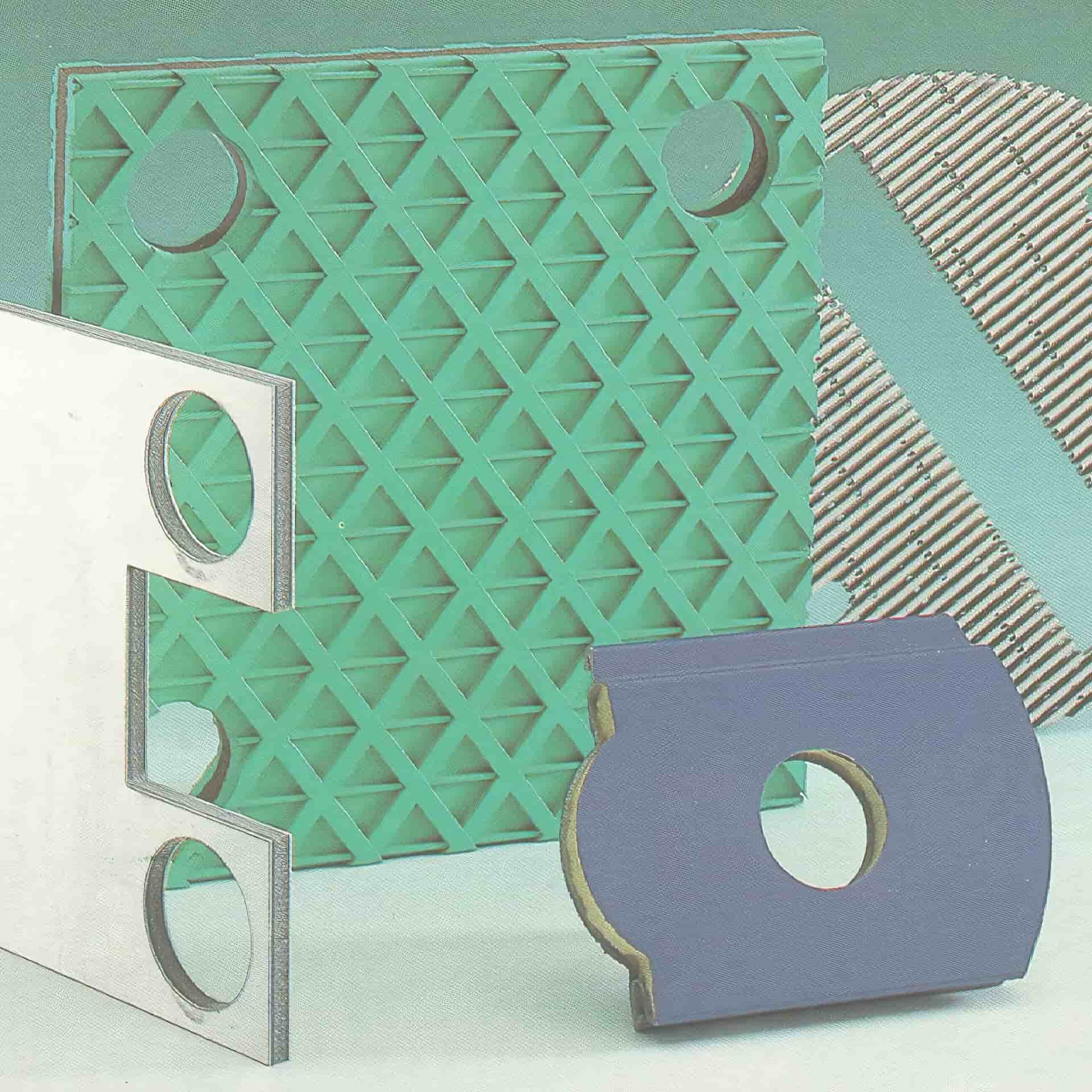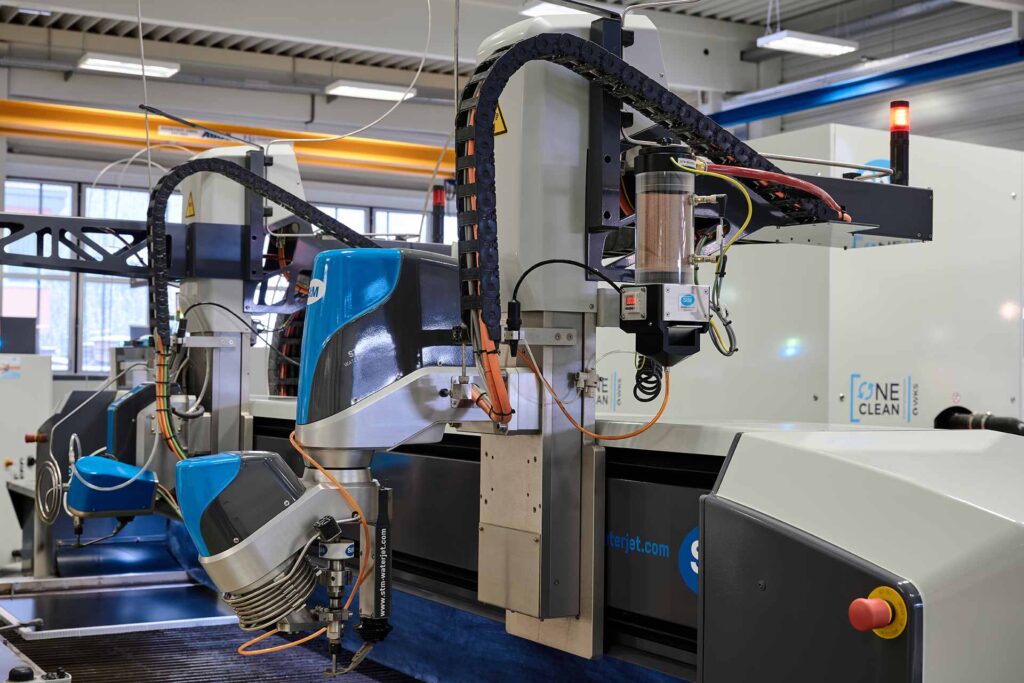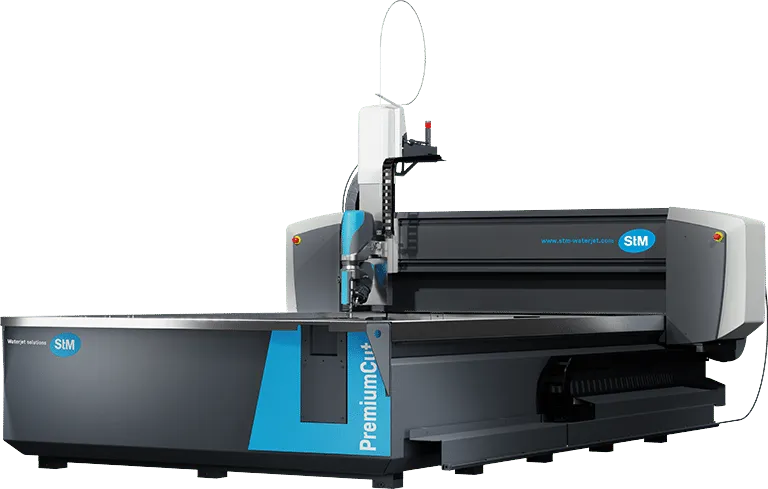Waterjet cutting composite
WPC (Wood-Plastic-Composite), MMC (Metal-Matrix-Composites) and many more.
Composites are combinations of different material properties. This makes the processing of composites difficult to control for conventional separation processes. Due to their very high hardness and tensile strength , composites can only be machined with expensive special tools and with great tool wear.
Waterjet cutting is a high-tech tool and offers the possibility of cutting all composite materials without tool wear and with the highest precision and quality. In this process, the water jet cuts without a heat-affected zone, thus avoiding structural changes to the sensitive fiber composites.
In addition, the process is very environmentally friendly, as no harmful fumes, chemicals or emissions are produced.
Table of contents
Table of contents
What types of composites can be cut?
Waterjet cutting can be used to cut different types of composite materials. These include fiber-reinforced plastics (FRP), as used in the aerospace and automotive industries. Likewise, composite metals are cut, which consist of different metals and are used primarily in aerospace and mechanical engineering. In addition, ceramic composites are processed, in which a ceramic matrix is reinforced with other materials and used in high-temperature applications, wear protection and electronics.
In addition, waterjet cutting also plays an important role in other composite materials. These include WPC (wood-plastic composite), which is a mixture of wood fibers and plastic and is often used in construction. Likewise, MMC (metal-matrix composites) are cut, in which metals such as aluminum or magnesium are combined with ceramic reinforcements to produce lightweight structures with high strength.
Thanks to its precision and material protection, waterjet cutting is the preferred method for processing these diverse composite materials in a wide range of industries.
- WPC (Wood-Plastic-Composite)
- MMC (metal matrix composites)
- AMC (ceramic matrix composites)
- NMC (Natural Fiber Matrix Composites)
- Fiber-reinforced plastics (FRP)
- Composite metals
- Ceramic composites
- Hybrid composites
Want more information on cutting composites with water?
5 Advantages – Waterjet Cutting Composite
Waterjet cutting of plastics offers a variety of advantages. The cut is made without thermal influence, which keeps the material properties of the plastic intact. There is no discoloration or melting edges on the cut edges, and the material retains its original quality.
The process enables high precision and fineness in cutting plastics. Even complex shapes and intricate details can be realized with great precision. In addition, waterjet cutting is extremely versatile and can process a wide range of plastics, regardless of their hardness, density or composition.
Waterjet cutting produces burr-free cut edges, which often eliminates the need for time-consuming mechanical finishing and thus saves time and money. In addition, the process is environmentally friendly as it does not produce harmful fumes, dust particles or exhaust gases. The water used can be recycled in many cases, resulting in a sustainable and resource-saving cutting solution for plastics.
Technical details
Waterjet cutting of composites is a high-precision cutting technology based on the use of a waterjet under high pressure. This water jet is amplified by nozzles containing a fine abrasive such as abrasive to make the cutting process more efficient.
The water jet is precisely directed at the material to be cut, whereby the pressure and diameter of the jet can be adjusted according to the specific requirements of the composite material.
CNC-controlled cutting systems enable high accuracy and repeatability of cuts. Modern waterjet cutting systems from STM offer a wide range of fine-tuning options and guarantee the highest precision and quality when cutting plastic.
In principle, thin materials with a thickness of just a few millimeters can be cut precisely. For example, thin-walled composite panels, foils and textiles. For thicker materials such as FRP, composite metals or ceramic composites, waterjet cutting can cut material thicknesses of several centimeters.
Any shape cuts and bevel cuts up to 60° are possible.
The cutting accuracy is usually +/- 0.1 mm.
In waterjet cutting, the cut quality is basically divided into 5 quality levels.
- Separating cut Q1 (for blanks / semi-finished products) Tolerance range 0.3 mm
- Standard cut Q3 (the most common cut) Tolerance range 0.2 mm
- Fine cut Q5 (for optimum dimensional accuracy) Tolerance range 0.1 mm
In waterjet cutting of composites, the achievable cutting speeds are usually in the range of 1000 to 4000 mm per minute.
As a rule, the water pressure for cutting composites is between 3000 and 6000 bar. These pressure ranges are typical for machining composite materials such as fiber-reinforced plastics (FRP), metal-matrix composites (MMC) and ceramic composites.
CNC control enables precise and repeatable cutting. The STM SmartCut cutting software offers high ease of use and functionality as well as flexibility.
References
The best advertising is known to be satisfied customers
Among our references you will find customers & partners from various fields. Among them are companies and facilities from the following industries:
- Metal industry
- Stone / Ceramics / Glass
- Plastics / foam industry
- Sealing industry
- Prototype / plant engineering
- Microwaterjet
- Educational Institutions
- Research
- Special materials
STM Product Finder
Find your work system – tailored to you
The individual wishes and requirements of our customers are the measure of all things for us. In order to be able to offer customized solutions for every requirement, we have developed a special product finder.
You tell us what you need to deliver perfect work and we put together the individual components and parts, as well as the associated software perfectly and individually. And if you are unsure, let your work material try our test cut.
FAQ – Frequently asked questions
The most frequently asked questions about waterjet cutting of carbon & fiberglass
We have collected some FAQ on the topic, waterjet cutting of carbon and fiberglass, and answered them succinctly for you.
If your question is not answered, please feel free to contact us directly.
Which composites can be cut with waterjet cutting?
oad cutting is suitable for a wide range of materials, including fiber-reinforced plastics (FRP), metal-matrix composites (MMC), ceramic composites and many more.
Is waterjet cutting a precise cutting method for composites?
Yes, waterjet cutting offers high precision and enables cutting of complex shapes and contours with tight tolerances.
Does waterjet cutting cause thermal damage to composites?
No, since the process cuts cold, there is no heat exposure and therefore no thermal damage to the material.
Which material thicknesses of composites can be cut with water?
Waterjet cutting can cut a wide range of material thicknesses, from thin foils and sheets to composite materials several centimeters thick.
Is waterjet cutting of composites environmentally friendly?
Yes, waterjet cutting is environmentally friendly because it produces no harmful emissions and recycled materials can be used as abrasives.
What is usually the water pressure for waterjet cutting of composites?
The water pressure is usually between 3000 and 6000 bar to give the water jet the required cutting energy.
Is waterjet cutting of composites preferred in certain industries?
Yes, waterjet cutting is widely used in industries such as aerospace, automotive, medical and construction because it offers a material-friendly and precise cutting solution for composites.


